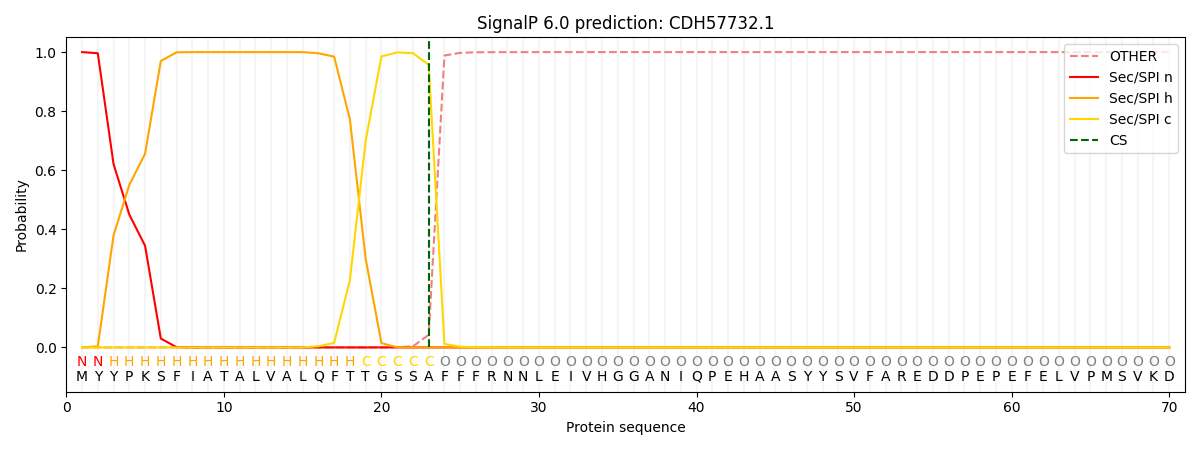You are browsing environment: FUNGIDB
CAZyme Information: CDH57732.1
You are here: Home > Sequence: CDH57732.1
Basic Information |
Genomic context |
Full Sequence |
Enzyme annotations |
CAZy signature domains |
CDD domains |
CAZyme hits |
PDB hits |
Swiss-Prot hits |
SignalP and Lipop annotations |
TMHMM annotations
Basic Information help
| Species | Lichtheimia corymbifera | |||||||||||
|---|---|---|---|---|---|---|---|---|---|---|---|---|
| Lineage | Mucoromycota; Mucoromycetes; ; Lichtheimiaceae; Lichtheimia; Lichtheimia corymbifera | |||||||||||
| CAZyme ID | CDH57732.1 | |||||||||||
| CAZy Family | PL14 | |||||||||||
| CAZyme Description | 3d domain protein | |||||||||||
| CAZyme Property |
|
|||||||||||
| Genome Property |
|
|||||||||||
| Gene Location | ||||||||||||
CDD Domains download full data without filtering help
| Cdd ID | Domain | E-Value | qStart | qEnd | sStart | sEnd | Domain Description |
|---|---|---|---|---|---|---|---|
| 270619 | 3D_domain | 3.56e-08 | 425 | 496 | 18 | 85 | 3D domain, named for 3 conserved aspartate residues, is found in mltA-like lytic transglycosylases and numerous other contexts. This family contains the 3D domain, named for its 3 conserved aspartates. It is found in conjunction with numerous other domains such as MltA (membrane-bound lytic murein transglycosylase A). These aspartates are critical active site residues of mltA-like lytic transglycosylases. Escherichia coli peptidoglycan lytic transglycosylase (LT) initiates cell wall recycling in response to damage, during bacterial fission, and cleaves peptidoglycan (PG) to create functional spaces in its wall. MltA has 2 domains, separated by a large groove, where the peptidoglycan strand binds. The C-terminus has a double-psi beta barrel fold within the 3D domain, which forms the larger A domain along with the N-terminal region of Mlts, but is also found in various other domain architectures. Peptigoglycan (also known as murein) chains, the primary structural component of bacterial cells walls, are comprised of alternating beta-1-4-linked N-acetylmuramic acid (MurNAc) and N-acetyl-D-glucosamine (GlcNAc); lytic transglycosylases (LTs) cleave this beta-1-4 bond. Typically, LTs are exolytic, releasing Metabolite 1 (GlcNAc-anhMurNAc-L-Ala-D-Glu-m-Dap-D-Ala-D-Ala) from the ends of the PG strands. In contrast, membrane-bound lytic murein transglycosylase E (MltE) is endolytic , cleaving in the middle of PG strands, with further processing to Metabolite 1 accomplished by other LTs. In E. coli, there are six membrane- bound LTs: MltA-MltF and soluble Slt70. Slt35 is a soluble fragment cleaved from MltB. Bacterial LTs are classified in 4 families: Family 1 includes slt70 MltC-MltF, Family 2 includes MltA, Family 3 includes MltB, and family 4 of bacteriophage origin. While most LTs are related members of the lysozyme-like lytic transglycosylase family, MltA represents a distinct fold and sequence conservation. |
| 197609 | LysM | 6.41e-08 | 170 | 214 | 2 | 44 | Lysin motif. |
| 212030 | LysM | 9.07e-08 | 111 | 154 | 4 | 45 | Lysin Motif is a small domain involved in binding peptidoglycan. LysM, a small globular domain with approximately 40 amino acids, is a widespread protein module involved in binding peptidoglycan in bacteria and chitin in eukaryotes. The domain was originally identified in enzymes that degrade bacterial cell walls, but proteins involved in many other biological functions also contain this domain. It has been reported that the LysM domain functions as a signal for specific plant-bacteria recognition in bacterial pathogenesis. Many of these enzymes are modular and are composed of catalytic units linked to one or several repeats of LysM domains. LysM domains are found in bacteria and eukaryotes. |
| 212030 | LysM | 1.34e-07 | 168 | 214 | 1 | 45 | Lysin Motif is a small domain involved in binding peptidoglycan. LysM, a small globular domain with approximately 40 amino acids, is a widespread protein module involved in binding peptidoglycan in bacteria and chitin in eukaryotes. The domain was originally identified in enzymes that degrade bacterial cell walls, but proteins involved in many other biological functions also contain this domain. It has been reported that the LysM domain functions as a signal for specific plant-bacteria recognition in bacterial pathogenesis. Many of these enzymes are modular and are composed of catalytic units linked to one or several repeats of LysM domains. LysM domains are found in bacteria and eukaryotes. |
| 396179 | LysM | 7.77e-06 | 170 | 209 | 1 | 37 | LysM domain. The LysM (lysin motif) domain is about 40 residues long. It is found in a variety of enzymes involved in bacterial cell wall degradation. This domain may have a general peptidoglycan binding function. The structure of this domain is known. |
CAZyme Hits help
| Hit ID | E-Value | Query Start | Query End | Hit Start | Hit End |
|---|---|---|---|---|---|
| 5.81e-276 | 3 | 528 | 2 | 499 | |
| 9.17e-109 | 8 | 528 | 7 | 415 | |
| 4.13e-101 | 8 | 528 | 7 | 438 | |
| 3.01e-13 | 112 | 214 | 189 | 296 | |
| 1.09e-12 | 111 | 214 | 207 | 333 |
Swiss-Prot Hits download full data without filtering help
| Hit ID | E-Value | Query Start | Query End | Hit Start | Hit End | Description |
|---|---|---|---|---|---|---|
| 1.50e-10 | 111 | 215 | 248 | 372 | LysM domain-containing protein ARB_05157 OS=Arthroderma benhamiae (strain ATCC MYA-4681 / CBS 112371) OX=663331 GN=ARB_05157 PE=1 SV=1 |
|
| 9.50e-06 | 112 | 154 | 268 | 310 | LysM domain-containing protein ARB_00327 OS=Arthroderma benhamiae (strain ATCC MYA-4681 / CBS 112371) OX=663331 GN=ARB_00327 PE=3 SV=2 |
SignalP and Lipop Annotations help
This protein is predicted as SP

| Other | SP_Sec_SPI | CS Position |
|---|---|---|
| 0.000270 | 0.999733 | CS pos: 23-24. Pr: 0.9571 |
